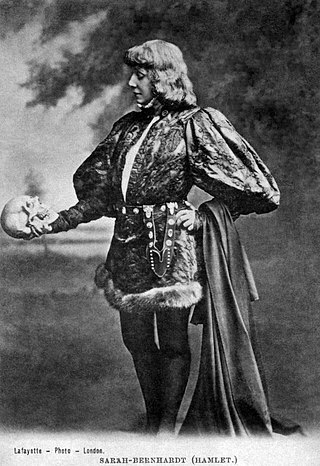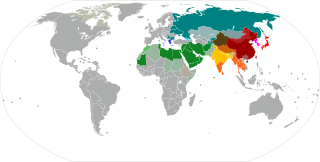
Acting is an activity in which a story is told by means of its enactment by an actor who adopts a character—in theatre, television, film, radio, or any other medium that makes use of the mimetic mode.

Chinese is a group of languages spoken natively by the ethnic Han Chinese majority and many minority ethnic groups in China. Approximately 1.35 billion people, or around 16% of the global population, speak a variety of Chinese as their first language.

Dubbing is a post-production process used in filmmaking and video production, often in concert with sound design, in which additional or supplementary recordings (doubles) are lip-synced and "mixed" with original production sound to create the finished soundtrack.
Punctuation marks are marks indicating how a piece of written text should be read and, consequently, understood. The oldest known examples of punctuation marks were found in the Mesha Stele from the 9th century BC, consisting of points between the words and horizontal strokes between sections. The alphabet-based writing began with no spaces, no capitalization, no vowels, and with only a few punctuation marks, as it was mostly aimed at recording business transactions. Only with the Greek playwrights did the ends of sentences begin to be marked to help actors know when to make a pause during performances. Punctuation includes space between words and the other, historically or currently used, signs.
Prose is the form of written language that follows the natural flow of speech, a language's ordinary grammatical structures, or typical writing conventions and formatting. It differs from traditional poetry, where the format consists of verse: writing in lines that follow rhythmic metre or a rhyme scheme. The word "prose" first appears in English in the 14th century. It is derived from the Old French prose, which in turn originates in the Latin expression prosa oratio.

In a written language, a logogram, also logograph or lexigraph, is a written character that represents a semantic component of a language, such as a word or morpheme. Chinese characters as used in Chinese as well as other languages are logograms, as are Egyptian hieroglyphs and characters in cuneiform script. A writing system that primarily uses logograms is called a logography. Non-logographic writing systems, such as alphabets and syllabaries, are phonemic: their individual symbols represent sounds directly and lack any inherent meaning. However, all known logographies have some phonetic component, generally based on the rebus principle, and the addition of a phonetic component to pure ideographs is considered to be a key innovation in enabling the writing system to adequately encode human language.
Diction, in its original meaning, is a writer's or speaker's distinctive vocabulary choices and style of expression in a poem or story. In its common meaning, it is the distinctiveness of speech: the art of speaking so that each word is clearly heard and understood to its fullest complexity and extremity, and concerns pronunciation and tone, rather than word choice and style. This is more precisely and commonly expressed with the term enunciation or with its synonym, articulation.

Patent ductus arteriosus (PDA) is a medical condition in which the ductus arteriosus fails to close after birth: this allows a portion of oxygenated blood from the left heart to flow back to the lungs through the aorta, which has a higher blood pressure, to the pulmonary artery, which has a lower blood pressure. Symptoms are uncommon at birth and shortly thereafter, but later in the first year of life there is often the onset of an increased work of breathing and failure to gain weight at a normal rate. With time, an uncorrected PDA usually leads to pulmonary hypertension followed by right-sided heart failure.

Kunqu, also known as Kunju (崑劇), K'un-ch'ü, Kun opera or Kunqu Opera, is one of the oldest extant forms of Chinese opera. It evolved from a music style local to Kunshan, part of the Wu cultural area, and later came to dominate Chinese theater from the 16th to the 18th centuries. It has been listed as one of the Masterpieces of the Oral and Intangible Heritage of Humanity by UNESCO. Wei Liangfu refined the musical style of kunqu, and it gained widespread popularity when Liang Chenyu used the style in his drama Huansha ji. In 2006, it was listed on the first national intangible cultural heritage list. In 2008, it was included in the List of Representative Works of Intangible Cultural Heritage of Humanity. In December 2018, the General Office of the Ministry of Education announced that Peking University is the base for inheriting excellent traditional Chinese culture in Kunqu.

Verse drama is any drama written significantly in verse to be performed by an actor before an audience. Although verse drama does not need to be primarily in verse to be considered verse drama, significant portions of the play should be in verse to qualify.
The Polonaise-Fantaisie in A-flat major, Op. 61, is a composition for piano by Frédéric Chopin. It was dedicated to Mme A. Veyret, written and published in 1846.
In linguistics, prosody is the study of elements of speech that are not individual phonetic segments but which are properties of syllables and larger units of speech, including linguistic functions such as intonation, stress, and rhythm. Such elements are known as suprasegmentals.

The term composition as it refers to writing, can describe authors' decisions about, processes for designing, and sometimes the final product of, a composed linguistic work. In original use, it tended to describe practices concerning the development of oratorical performances, and eventually essays, narratives, or genres of imaginative literature, but since the mid-20th century emergence of the field of composition studies, its use has broadened to apply to any composed work: print or digital, alphanumeric or multimodal. As such, the composition of linguistic works goes beyond the exclusivity of written and oral documents to visual and digital arenas.
In literature and other artistic media, a mode is an unspecific critical term usually designating a broad but identifiable kind of literary method, mood, or manner that is not tied exclusively to a particular form or genre. Examples are the satiric mode, the ironic, the comic, the pastoral, and the didactic.
Characterization or characterisation is the representation of characters in narrative and dramatic works. The term character development is sometimes used as a synonym. This representation may include direct methods like the attribution of qualities in description or commentary, and indirect methods inviting readers to infer qualities from characters' actions, dialogue, or appearance. Such a personage is called a character. Character is a literary element.

An audition is a sample performance by an actor, singer, musician, dancer or other performer. It typically involves the performer displaying their talent through a previously memorized and rehearsed solo piece or by performing a work or piece given to the performer at the audition or shortly before. In some cases, such as with a model or acrobat, the individual may be asked to demonstrate a range of professional skills. Actors may be asked to present a monologue. Singers will perform a song in a popular music context or an aria in a Classical context. A dancer will present a routine in a specific style, such as ballet, tap dance or hip-hop, or show his or her ability to quickly learn a choreographed dance piece.

A writing system comprises a particular set of symbols, called a script, as well as the rules by which the script represents a particular language. Writing systems can generally be classified according to how symbols function according to these rules, with the most common types being alphabets, syllabaries, and logographies. Alphabets use symbols called letters that correspond to spoken phonemes. Abjads generally only have letters for consonants, while pure alphabets have letters for both consonants and vowels. Abugidas use characters that correspond to consonant–vowel pairs. Syllabaries use symbols called syllabograms to represent syllables or moras. Logographies use characters that represent semantic units, such as words or morphemes.
Charles Perfetti is the director of, and Senior Scientist for, the Learning and Research Development Center at the University of Pittsburgh. His research is centered on the cognitive science of language and reading processes, including but not limited to lower- and higher-level lexical and syntactic processes and the nature of reading proficiency. He conducts cognitive behavioral studies involving ERP, fMRI and MEG imaging techniques. His goal is to develop a richer understanding of how language is processed in the brain.
The rhythm dance (RD) is the first segment of an ice dance competition. The International Skating Union (ISU) renamed the short dance to the "rhythm dance" in June 2018, prior to the 2018–2019 season. It became part of international competitions in July 2018. French ice dancers Gabriella Papadakis and Guillaume Cizeron hold the highest RD score of 90.83 points, which they achieved at the 2022 Beijing Winter Olympics.










